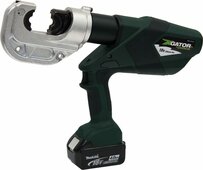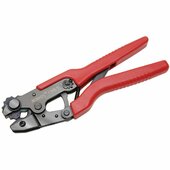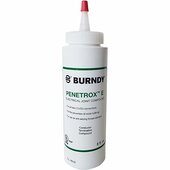Fancy stuff
I had.... Past tense an old timey resistance bridge for doing leads wingdings and connections.
I don't recall the resolution on the meter but it needed calibration from time to time and this was never done in a timely manner so when people tell me resistance figures as low as you I ask what your using ( sound like the right tool )
Really the best crimp your going to get is with a tool like this if you can borrow one.
They are consistent and reliable crimps that inspectors like to see because of the dye marking indicating the proper crimp was done
View attachment 212429
I see pin crimpers like this for sale very cheap at places like Princess Auto.
They work, but Inspectors don't like them because you can't be sure of the quality of the crimp done.
You can get a feel for it and I believe I can make a good quality connection with it but the inspectors feel different, you may feel different but I don't recommend anyone who is not very comfortable with this type of tool use one
View attachment 212430
This is a DMR-2 hand crimper and I have an earlier version of it I keep but really don't use.
It does have dyes and it does leave a number impression to indicate it has been crimped to a specification but my experience has been very hit and miss with these small hand crimpers.
I have seen connections pull apart that tells me they are not that good.
By pull parts I am talking about a portable power cable( giant extension cords 2/0 or smaller this tool only crimps up to #2 however )
If it pulls apart its probably not a good cold weld...
View attachment 212435
On small portable power cables that really matter to me I have been known to crimp and solder the connection before I tape ( talking splices now )
Joint compound.
I use this stuff on copper too copper connections where required.
If I have old unplated copper bus I will clean the bus with a scotchbright and use this stuff.
if its plated copper on plated copper connection I am told I don't need to use this as long as the plating is clean and bright
Sometimes I use it anyways.
I like to use it on bond connections ( for example a stainless encloser and copper mechanical or compression lug )
Does it make make for cooler running connections?
Its is suposed to...
View attachment 212432
Where ever you have two metals that are dissimilar bolted together you have a situation where they will try and alloy together and corrode in a way to make a buffer material between the two metals that the two different metals are more comfortable with.
In aluminum copper connections this is much worse.
The copper alloys to aluminum and forms oxides that scale up in between the connections and this pushes and slides and moves scaly white high resistance crude between the copper and aluminum.
This creates a high resistance a joint that will get hot and fail.
Any joint thats heating and cooling will fail eventually is it can start the process of corrosion
I have seen aluminum mechanical lugs turn to dust between an stainless electrical box and a copper bond cable
I have not done a lot of solar ( really nothing at all )
But I have fixed things for people at cottages and such.
I am seeing a lot of cable failures to corrosion.
I see a lot of aluminum lugs on stainless with copper wire and everything is rated and designed to be OK for that, but its still failing.
Where you can I think you are better off to try and stick with copper period.
That means copper wire, copper mechanical or compression lugs copper ( red brass ) bolts .
Where I have used obly this kind of hardware I have not had to come back and fix them again ( for good measure I use that Pentrox, and I suspect that you could just use copper anti sieze instead but you are not suposed to do that )







